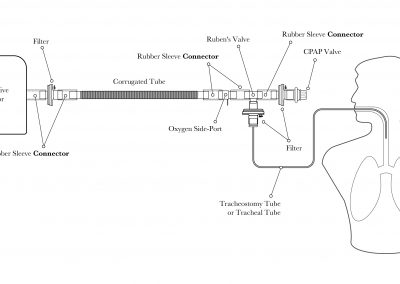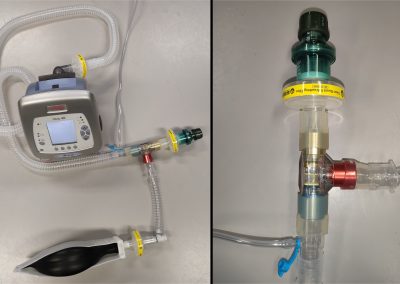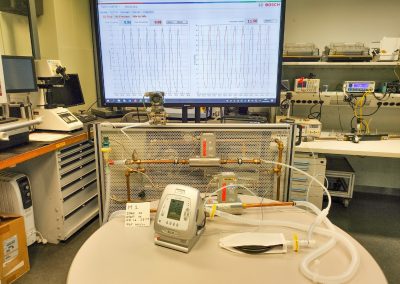Conversion of Non-Invasive Ventilator into Invasive Mechanical Ventilation
Summary
Already validated, this is an immediate solution for invasive ventilator shortages worldwide, at a very low cost.
It allows to adapt non-invasive ventilators to be used as Invasive Mechanical Ventilators, using equipment already widely available on hospitals and on the market.
Not intended to be equated in any way with a differentiated ventilator for Invasive Mechanical Ventilation, on crisis scenarios such as Covid-19 pandemic context, in a situation of imminent risk to the patient’s life and in the absence of an ICU ventilator, the solution is a safe, practical and effective alternative.
- Results were already submitted on European Journal of Anaesthesiology, peer-reviewed and accepted for publication.
- Formal Request Submitted to Infarmed (Portuguese National Authority of Medicines and Health Products, I.P.), formally subscripted by 180 doctors (in Portuguese).
Details
- Technical details.
- Step by step Assembly Manual
- Infarmed Request (In Portuguese)
- Video: Circuit
- Video: Validation Trials at Bosch
- Dr. Paulo Roberto Presentation Letter (In Portuguese)
Why is it different from other solutions
- Hospitals worldwide can build it in-house, today and for less than 5€.
- Already scientifically reviewed and validated.
- Does not imply future overstocking of mechanical ventilators.
- Does not require healthcare professionals any additional training.
What’s next
- Reach health teams around the world and provide them with the step by step Assembly Manual.
- Get formal support from health regulatory agencies in order to license its widespread use.
- We intend to legally declare we do not want to make a profit out of it.
Team
- Paulo-Roberto Ferreira, Department of Anaesthesiology, Centro Hospitalar de Vila Nova de Gaia / Espinho, Portugal. Department of Medical Sciences, Univerity of Aveiro, Portugal.
Project role: Concept design, clinical application. - Tiago Oliveira-e-Sá, Pulmonology Department, Hospital de Santa Marta, Centro Hospitalar Universitário de Lisboa Central, Portugal; NOVA Medical School, Faculdade de Ciências Médicas, Universidade Nova de Lisboa, Portugal.
Project role: Concept design, clinical application. - Duarte Almeida, Process Development and I4.0 engineering, Bosch Thermotechnology, Portugal.
Project role: Testing equipment development, automation, instrumentation and Engineering coordination. - Vitor Silva, R&D Laboratory Management, Bosch Thermotechnology, Portugal.
Project role: Measuring equipment development, mechanics, instrumentation and post-processing data algorithms. - Filipe Rego, Manufacturing Engineering, Bosch Thermotechnology, Portugal.
Project role: Labview sw development and intrumentation advisory. - Nuno Mateus, Quality Process, Quality and Safety, Bosch Thermotechnology, Portugal.
Project role: Sensor calibration and statistical analysis. - André Cunha, Metallurgical and Materials Engineer, Fernando Pinto Catão & Irmão Lda., Portugal
Project role: Connectors design and industrialization.
Partnerships and Aknowledgements
- Department of Anaesthesiology, Centro Hospitalar de Vila Nova de Gaia/Espinho – Portugal.
- Department of Medical Sciences, Universidade de Aveiro, Portugal.
- Pulmonology Department, Hospital de Santa Marta, Centro Hospitalar Universitário de Lisboa Central, Portugal.
- NOVA Medical School, Faculdade de Ciências Médicas, Universidade Nova de Lisboa, Portugal.
- Bosch Thermotechnology Portugal: laboratorial equipment and facilities.
- Rita Meireles (Intensive Care Unit, CHTS, Portugal), Ana Bernardino (Anaesthesiology Department, CHUC, Portugal) and Francisco Soares (Cardiology Department, HSA/HDL, Portugal): conceptual development, clinical validation and scientific reviewing.
- Francisco Pitschieller (freelancer technical designer): diagrams and “User’s Manual” design.
- Pedro Menezes (FEUP, Portugal); Daniel Vasconcelos (IESCTEC/FEUP, Portugal), Rui Oliveira (Trativi, Portugal): silicon connector development.
- Helpful Engineering: platform for network creation.
- Breas Portugal and Linde Portugal: for borrowing ventilators, circuits and valves.
- Giammarco Casanova, Caroline Mindus, Andrius Zhilenas, Yahya Mohamed Mao among others for mentoring our project during EUvsVirus.org Hackathon.
- Ricardo Castro (freelancer): for his help creating the video.
- Tiago Moura (I4.0 Engineer, Bosch Thermotechnology, Portugal): for helping in the testing equipment assembly.
Contacts:
Paulo-Roberto C Ferreira, anesthesiologist; Pauloroberto.xpta@gmail.com; +351 967 546 707
Keywords
Ventilator, Invasive Mechanical Ventilation, Treatment, Lung, Covid-19, Solution, Immediately Available
Associated Users
Location
Porto, Portugal
Entities
Departamento de Ciências Médicas, Universidade de Aveiro.
Centro Hospitalar de Vila Nova de Gaia / Espinho.
European Cluster Collaboration Platform.



0 Comments